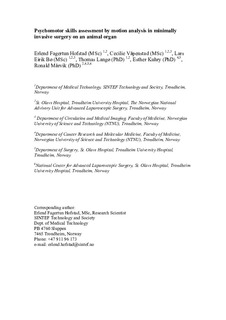| dc.contributor.author | Hofstad, Erlend Fagertun | |
| dc.contributor.author | Våpenstad, Cecilie | |
| dc.contributor.author | Bø, Lars Eirik | |
| dc.contributor.author | Langø, Thomas | |
| dc.contributor.author | Kuhry, Esther | |
| dc.contributor.author | Mårvik, Ronald | |
| dc.date.accessioned | 2018-02-02T07:37:13Z | |
| dc.date.available | 2018-02-02T07:37:13Z | |
| dc.date.created | 2017-05-31T12:45:03Z | |
| dc.date.issued | 2017 | |
| dc.identifier.citation | MITAT. Minimally invasive therapy & allied technologies. 2017, 26 (4), 240-248. | nb_NO |
| dc.identifier.issn | 1364-5706 | |
| dc.identifier.uri | http://hdl.handle.net/11250/2482287 | |
| dc.description.abstract | Background: A high level of psychomotor skills is required to perform minimally invasive surgery (MIS) safely. To be able to measure these skills is important in the assessment of surgeons, as it enables constructive feedback during training. The aim of this study was to test the validity of an objective and automatic assessment method using motion analysis during a laparoscopic procedure on an animal organ. Material and methods: Experienced surgeons in laparoscopy (experts) and medical students (novices) performed a cholecystectomy on a porcine liver box model. The motions of the surgical tools were acquired and analyzed by 11 different motion-related metrics, i.e., a total of 19 metrics as eight of them were measured separately for each hand. We identified for which of the metrics the experts outperformed the novices. Results: In total, two experts and 28 novices were included. The experts achieved significantly better results for 13 of the 19 instrument motion metrics. Conclusions: Expert performance is characterized by a low time to complete the cholecystectomy, high bimanual dexterity (instrument coordination), a limited amount of movement and low measurement of motion smoothness of the dissection instrument, and relatively high usage of the grasper to optimize tissue positioning for dissection. | nb_NO |
| dc.language.iso | eng | nb_NO |
| dc.publisher | Taylor & Francis | nb_NO |
| dc.title | Psychomotor skills assessment by motion analysis in minimally invasive surgery on an animal organ | nb_NO |
| dc.type | Journal article | nb_NO |
| dc.type | Peer reviewed | nb_NO |
| dc.description.version | acceptedVersion | nb_NO |
| dc.source.pagenumber | 240-248 | nb_NO |
| dc.source.volume | 26 | nb_NO |
| dc.source.journal | MITAT. Minimally invasive therapy & allied technologies | nb_NO |
| dc.source.issue | 4 | nb_NO |
| dc.identifier.doi | 10.1080/13645706.2017.1284131 | |
| dc.identifier.cristin | 1473150 | |
| dc.description.localcode | This is an [Accepted Manuscript] of an article published by Taylor & Francis in [Minimally Invasive Therapy & Allied Technologies ] on [08 Feb 2017], available at http://www.tandfonline.com/doi/full/10.1080/13645706.2017.1284131. Locked until 8.2.2018 due to copyright restrictions. | nb_NO |
| cristin.unitcode | 194,65,25,0 | |
| cristin.unitcode | 194,65,15,0 | |
| cristin.unitname | Institutt for sirkulasjon og bildediagnostikk | |
| cristin.unitname | Institutt for klinisk og molekylær medisin | |
| cristin.ispublished | true | |
| cristin.fulltext | postprint | |
| cristin.qualitycode | 1 | |
